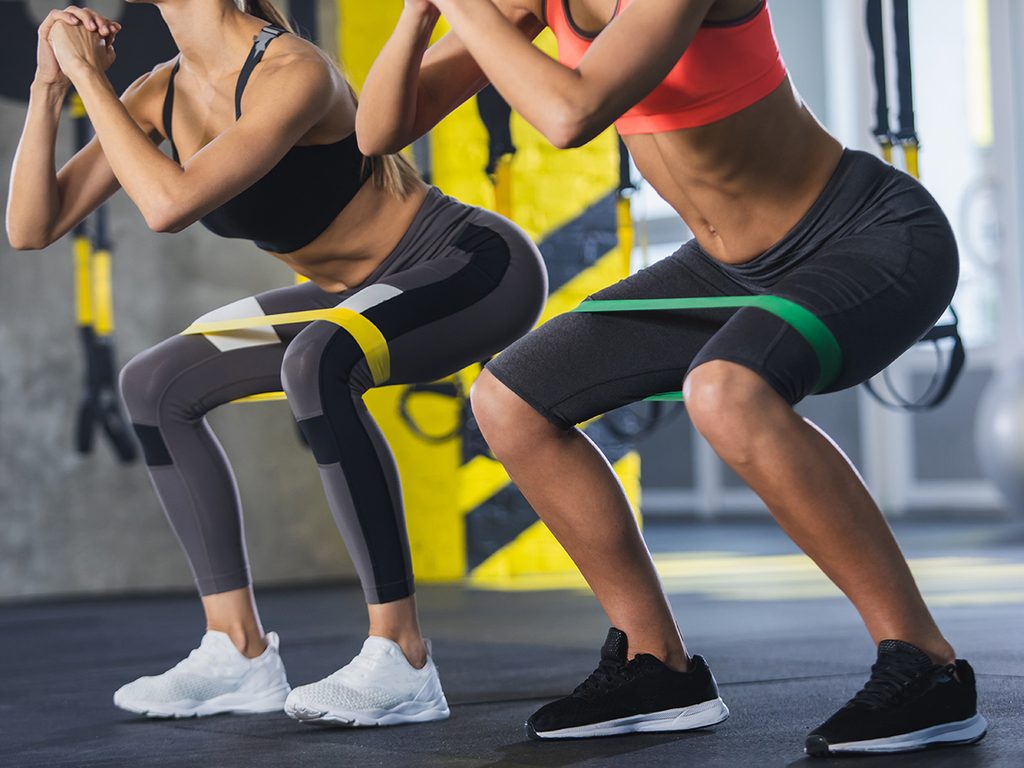Your Guide to a Leak-Free Workout (Yes, We’re Talking About Pee)

Mild to moderate incontinence is a real issue for lots of women. Here are some tips to ensure you make the right kind of splash in your workout clothes.
For many early devotees of CrossFit, it became de rigeur to have a wee barf after a workout, a badge of honour that you’d worked hard. (Some gyms even still feature posters with a Pukie the Clown mascot.) Then it became pee’s time to make a splash, with videos of CrossFit championships zeroing in on the puddles around the feet of many of the nonchalant female competitors.
Sure, it’s nice to see women unembarrassed by bodily fluids, but let’s not confuse common with normal. “It’s really not a good sign,” says Toronto-based pelvic floor physiotherapist Michele Fraser. “It’s telling me that your pelvic floor is off balance and experiencing some form of dysfunction and can use some assistance.”
While the term “athletic incontinence” is gaining a bit of steam, this kind of peeing falls under the “stress urinary incontinence” umbrella — that is, sudden peeing brought on by exercise, coughing or laughing. It’s not limited to affecting competitive CrossFitters, either, but tennis players, Frisbee chasers, Pilates-doers, basically anyone moving their body.
It’s largely caused by a weak pelvic floor — the hammock of muscles, ligaments and fascia that hangs out just below your bladder. Aging, past or current pregnancies, and being overweight can cause these bungee cords to soften and slacken, and lax bungee cords aren’t great at keeping stuff locked down.
The problem can even be traced to your urethra, says Fraser, which has a mucosal lining that makes the tube’s sides stick together. But a lack of estrogen (caused by post-partum hormone fluctuations, or having chemo, or perimenopause, or menopause) causes everything to dry up – including the urethra, leaving that crucial seal less Velcro-y and leaving you with leaks.
And then there’s pelvic organ prolapse, where your bladder (the cystocele form of prolapse), rectum (rectocele), and uterus (uterine) lose their footing and collapse towards and into the vagina. If your bladder prolapses, it will hang below your urethra, not above it (think water in a slumped balloon) and cause both leaking and a feeling of never being empty.
(Related: 9 Questions About Menopause You’ve Been too Embarrassed to Ask)
Getting some help
Exercise is crucial for our mental and physical health, but dribbles and deluges of pee are a pretty off-putting side effect. So what to do? First, keep a diary of when it’s happening. Then, make an appointment with a pelvic floor physiotherapist.
For your first appointment, expect a lot of awkward questions. “I always tell new clients, ‘Listen, I talk about pee, poo and sex all day,’” says Fraser. “Nothing surprises me.” Next, there’s an internal exam, either inside the vagina or in the anus, or both, so she can map out your pelvic floor, identifying its weakness and its tensions. (This won’t happen, obviously, if your examination is virtual, where the assessment will be based on you sharing your symptoms.) “Every pelvic floor tells me a different story,” she says, with 99 percent of clients presenting with a combo of weak and tense muscles. And then: The Plan.
If you were raised on the advice of women’s mags to bang out a few simple Kegels at traffic lights, get ready: today’s pelvic floor exercises are a whole lot more sophisticated and nuanced. Never mind the ol’ squeeze-like-you’re-stopping-a-pee clunker. One cue Fraser uses, for example: Imagine a flaxseed at the tip of your urethra. Now imagine pulling it up inside, like an elephant drinking water with its trunk.
But doing these exercises in combination with other tools, such as using localized estrogen (it comes in cream, tablet and capsule form) to help improve the integrity of the tissue, should help enormously. You can even put a dab of vaginal moisturizer (Fraser likes the brand Damiva, made in Toronto and available at drug stores) at the tip of your urethra to help it close properly. In the meantime, disposable incontinence products and pee-proof undies can help not only keep you from awkward incidents, but be a great way to gauge your progress.
A doctor may suggest a pessary as well, a device that is inserted into the vagina to provide a bit of support for the urethra while you exercise. (Picture a bit of scaffolding propping up the Tower of Pisa), and there are surgical options for serious cases.
(Related: 5 Yoga Poses that are Better than Kegels)
Just tell me how the hell I can work out
Fraser is very clear that there is no easy do-this/don’t do that solution here, and that it’s not the exercise necessarily, but how you’re doing it, and if your core and intra-abdominal muscles (which are intimately connected to your pelvic floor) are being used properly. That said…
(Related: 4 Key Body Parts—Including the Pelvis—You Should Exercise Now)
Sure, wear whatever
Typically, walking, swimming and cycling are considered “safe” activities, as they put very little strain on your bladder, but everyone is different, and any activity over time can cause your muscles to weaken – and your bladder to fill up, too! So while you may feel great at the beginning of the hike, you may be surprised by the end.
(Related: Why Going to the Bathroom “Just in Case” Is a Bad Idea)
Maybe throw on the pee-proof undies
Due to their lack of bouncy, sudden movements, Pilates and yoga may seem like innocuous forms of exercise, but can be trouble-makers: if you’re doing crunches or 100s, you can be putting pressure on your bladder, while Chaturanga and navasana (boat pose) can cause you to over grip and spill.
And also a pad
Anything high impact can cause trouble, as can holding in your breath (it creates pressure in the intra abdominal space). Lifting heavy weights overhead can also be tough, and sports that involve a lot of changes in direction and stop-start running (like hockey and tennis) can overload your pelvic floor, too.
(Related: The Natural Way To Treat Incontinence)
And also bring a shirt to wrap around your waist
As anyone who does CrossFit will tell you, double unders (skipping rope, but with two rounds of the rope with every jump) are the number one way to guarantee making a splash.
Next: How to Stop Bladder Leaks From Dictating Your Social Calendar




